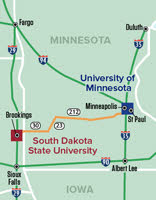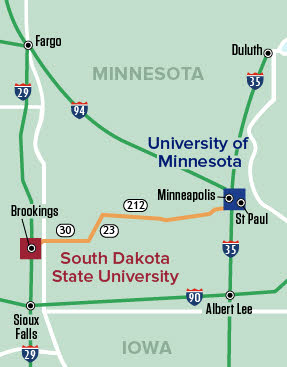
SDSU map

Design by Tamara Rees
A joint veterinary program planned to open in 2021 will have students begin their studies at South Dakota State University in Brookings and finish at the University of Minnesota in St. Paul. The campuses are about 200 miles apart.
When South Dakota State University joins with the University of Minnesota to offer a veterinary degree, theirs will be the fifth such cooperative program in the country, but different from the others in an important respect:
South Dakota will be the first to compel some students who receive state aid to return home to practice.
Legislation signed by the governor last month requires at least six students per class to return to South Dakota within a year of graduation to practice in the state for at least four years.
The students subject to the requirement are anticipated to be "the six most highly qualified South Dakota residents," who will be offered "the greatest scholarship levels" from the state, according to Dennis Hedge, provost and vice president of academic affairs at SDSU.
Other South Dakota residents accepted to the program will be eligible for scholarships, as well, Hedge said, but for lesser amounts.
Scholarship details are being worked out still, but overall, Hedge said in an interview by email, "[W]e are anticipating that this program should reduce the cost of obtaining a DVM degree by approximately $100,000 per student over the course of their four-year program when compared to the average out-of-state tuition rate that most of our SD students would have to pay if this program was not created."
Reducing the cost to state residents of becoming veterinarians and expanding the state's rural veterinary workforce are key reasons given by advocates for establishing the program at SDSU. Under the plan, about 20 students per year begin their veterinary school studies at SDSU. After two years in South Dakota, they move to the University of Minnesota's long-established College of Veterinary Medicine to complete the four-year degree.
South Dakota residents in the program, called a 2+2, would pay the same tuition as Minnesota residents. The current in-state cost of attendance at UMN, including living expenses, is $50,862 per year. The current annual cost for out-of-state students is $76,368.
Hedge said UMN will not receive any funds from South Dakota to offset the discounted tuition rate offered to participating South Dakota residents. (In some cooperative programs, the sending states pay the receiving institutions the difference between in-state and out-of-state tuition.)
The partnership was proposed by Dr. Trevor Ames, dean of the veterinary school in Minnesota, as a way to attract more students interested in rural practice. Ames told the VIN News Service last year that 30% to 40% of UMN students focus on mixed animal or food animal medicine. The college enrolls about 105 new veterinary students annually.
The cooperative program is anticipated to accept its first students in 2021. The new South Dakota law redirects to the SDSU program state funds that previously were used to offset the price of attending veterinary school at Iowa State University for six South Dakotans per year. The state subsidy made up the difference between in-state and out-of-state charges.
Most University of Nebraska grads returned voluntarily, survey shows
Iowa State has a 2+2 program of its own, dating to 2007, with the University of Nebraska-Lincoln. For participating Nebraska residents, the state of Nebraska pays the difference between nonresident and resident tuition while they are at Iowa State but does not require them to return to Nebraska to practice, according to Dr. Renee McFee, coordinator of the UNL Professional Program in Veterinary Medicine.
The school does attempt to follow the whereabouts of its alumni. A survey found that as of May 2018, 110 of 170 alumni were located in Nebraska. The 170 alumni represent 89% of all 191 graduates, dating to the class of 2011, McFee said.
Of 110 alumni who reported being in Nebraska, 47 were located in the vicinity of Omaha — the largest city in the state — and Lincoln, the state capital. The rest were scattered across Nebraska.
The survey found that 44.5% were in companion animal practice, 31% in mixed animal or food animal practice, and 4.7% in equine practice. The rest were in academia, industry, government, other or unknown.
The university has posted alumni data in the form of a map of the state, a map of the U.S. and a chart showing distribution by practice type.
Utah sees veterinary population boom
Utah State University has a 2+2 program with Washington State University that began in 2012. The state pays to WSU the differential between in-state and out-of-state tuition for the two years that participating Utah residents attend WSU, according to associate dean Dr. Dirk Vanderwall.
Three classes have graduated so far, for a total of about 90 alumni. School records show that 33 alumni are working in Utah, Vanderwall said. (Some alumni are from outside Utah, as the program accepts out-of-state residents, who pay nonresident tuition rates.)
Utah is experiencing a boom in its population of veterinarians, a trend that some have attributed to the veterinary program at Utah State.
However, Utah state licensing records show that the trend extends back to at least 2005, 11 years before the first class at Utah State graduated.
Figures supplied by the state Division of Occupational and Professional Licensing show 863 licensed veterinarians in Utah in 2017, compared with 549 in 2005, an increase of 57%. State population growth was 24% during the same period, judging from figures on statistica.com.
In Montana, six of 11 in inaugural class returned
Montana State University also has a cooperative program with WSU, but the configuration is 1+3: Participating Montana residents spend their first year of veterinary school at Montana State before moving to WSU for three years to complete the degree.
While at WSU, Montana resident students pay the same tuition as Washington state residents; the state of Montana pays WSU the difference between resident and nonresident tuition on the students' behalf, according to the program director, Mark Quinn. However, he said, the state does not require the students to work in Montana after graduating. Still, he said, "The majority of them want to."
Begun in 2014, the program graduated its first class in 2018. Of 11 alumni in that group, Quinn said he's aware of six who returned to Montana to practice, and two more expressed intentions to return after completing post-graduate training elsewhere.
Quinn said he doesn't yet know the destinations of students in the class of 2019. The program probably will institute a formal method of tracking alumni in order to provide periodic reports to the state Legislature, he said.
Alaska graduates first class in May; half or more expected to return
The newest existing cooperative program pairs the University of Alaska at Fairbanks with Colorado State University. Begun in 2015, the program graduates its inaugural class of 10 students in May.
Alaska residents in the program pay in-state tuition equal to Colorado's in-state tuition during their two years at UAF and are assessed out-of-state tuition while in Colorado, according to Dr. Karsten Hueffer, associate dean. In other words, the state of Alaska does not subsidize the out-of-state portion of their education, nor does it require graduates to practice in the state.
Nevertheless, of the 10 soon-to-be-graduates, Hueffer said by email that he knows of at least five who plan to work in Alaska. Four are Alaska residents and one is from Pennsylvania, he said. Hueffer added, "There might be more coming back."